The Cambridge History of China. Vol. 13: Republican China 1912-1949, Part 2
Подождите немного. Документ загружается.

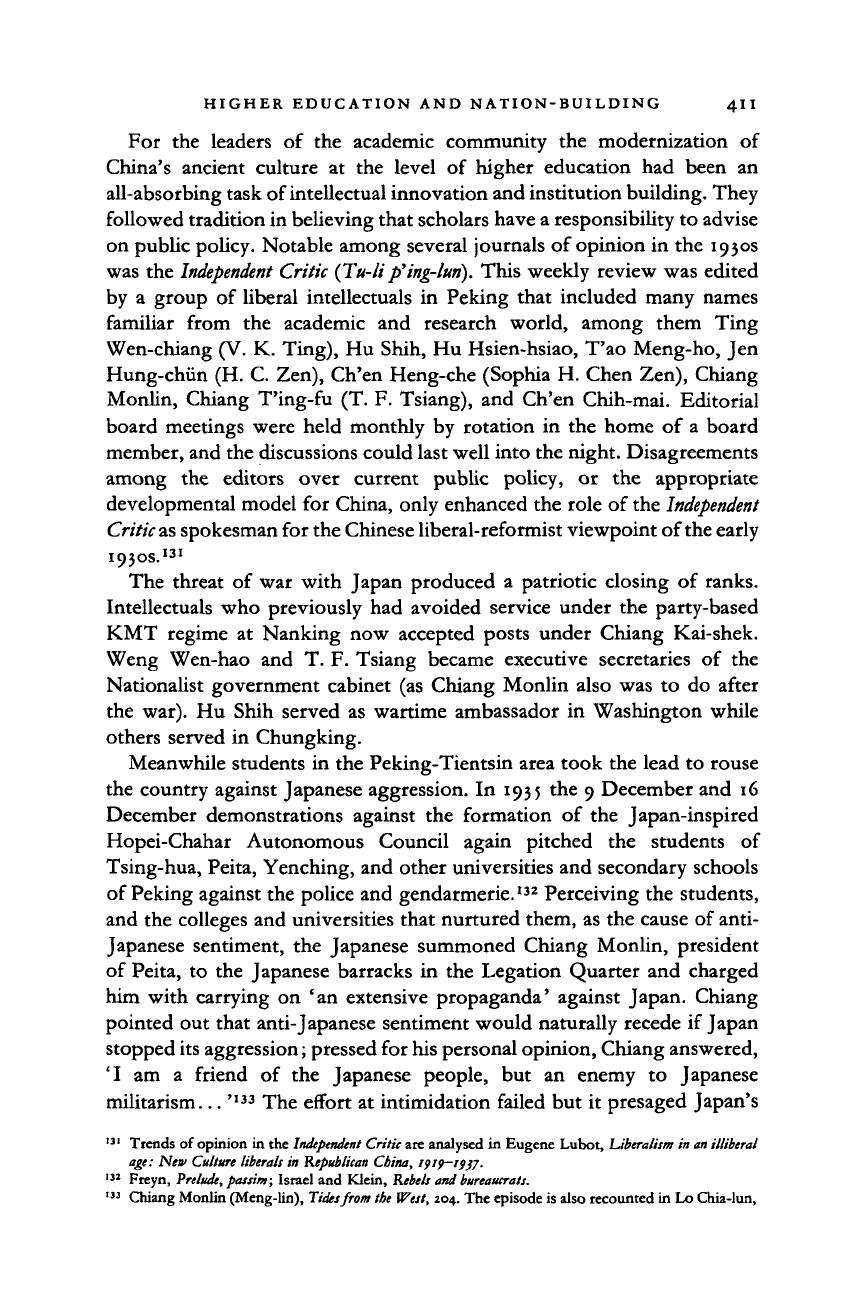
HIGHER EDUCATION AND NATION-BUILDING 411
For the leaders of the academic community the modernization of
China's ancient culture at the level of higher education had been an
all-absorbing task of intellectual innovation and institution building. They
followed tradition in believing that scholars have a responsibility to advise
on public policy. Notable among several journals of opinion in the 1930s
was the
Independent
Critic {Tu-lip'ing-luri). This weekly review was edited
by a group of liberal intellectuals in Peking that included many names
familiar from the academic and research world, among them Ting
Wen-chiang (V. K. Ting), Hu Shih, Hu Hsien-hsiao, T'ao Meng-ho, Jen
Hung-chiin (H. C. Zen), Ch'en Heng-che (Sophia H. Chen Zen), Chiang
Monlin, Chiang T'ing-fu (T. F. Tsiang), and Ch'en Chih-mai. Editorial
board meetings were held monthly by rotation in the home of a board
member, and the discussions could last well into the night. Disagreements
among the editors over current public policy, or the appropriate
developmental model for China, only enhanced the role of the
Independent
Critic
as
spokesman for the Chinese liberal-reformist viewpoint of the early
1930s.
131
The threat of war with Japan produced a patriotic closing of ranks.
Intellectuals who previously had avoided service under the party-based
KMT regime at Nanking now accepted posts under Chiang Kai-shek.
Weng Wen-hao and T. F. Tsiang became executive secretaries of the
Nationalist government cabinet (as Chiang Monlin also was to do after
the war). Hu Shih served as wartime ambassador in Washington while
others served in Chungking.
Meanwhile students in the Peking-Tientsin area took the lead to rouse
the country against Japanese aggression. In 1935 the 9 December and 16
December demonstrations against the formation of the Japan-inspired
Hopei-Chahar Autonomous Council again pitched the students of
Tsing-hua, Peita, Yenching, and other universities and secondary schools
of Peking against the police and gendarmerie.
132
Perceiving the students,
and the colleges and universities that nurtured them, as the cause of anti-
Japanese sentiment, the Japanese summoned Chiang Monlin, president
of Peita, to the Japanese barracks in the Legation Quarter and charged
him with carrying on 'an extensive propaganda' against Japan. Chiang
pointed out that anti-Japanese sentiment would naturally recede if Japan
stopped its aggression; pressed for his personal opinion, Chiang answered,
'I am a friend of the Japanese people, but an enemy to Japanese
militarism... '
I33
The effort at intimidation failed but it presaged Japan's
131
Trends of opinion in the
Independent
Critic ate analysed in Eugene Lubot, Liberalism in an illiberal
age:
New
Culture liberals in Republican China, 1919-1937.
132
Freyn, Prelude, passim; Israel and Klein, Rebels and bureaucrats.
133
Chiang Monlin (Meng-lin), Tides from the West, 204. The episode is also recounted in Lo Chia-lun,
Cambridge Histories Online © Cambridge University Press, 2008
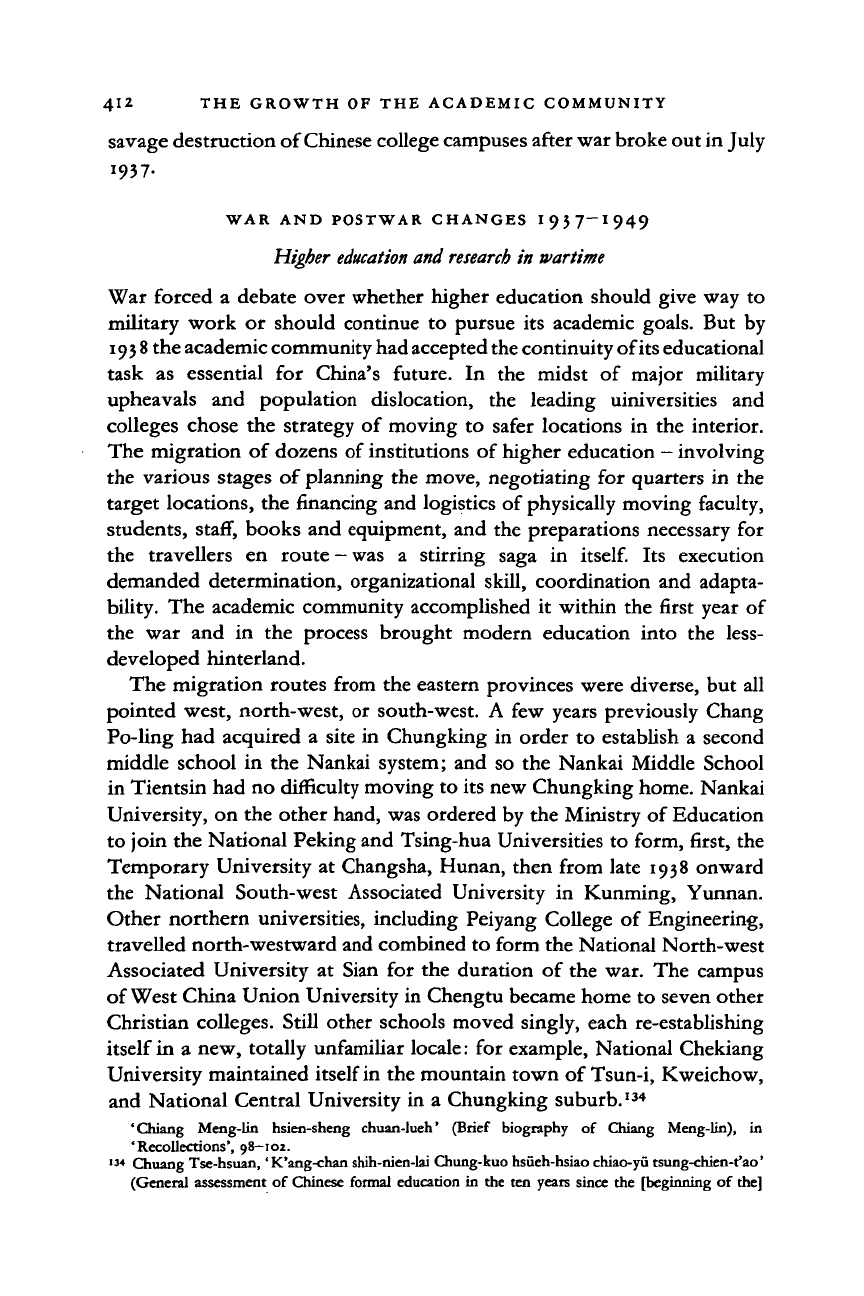
412
THE
GROWTH
OF THE
ACADEMIC COMMUNITY
savage destruction of Chinese college campuses after war broke out in July
1937-
WAR AND POSTWAR CHANGES 1937-1949
Higher
education
and
research
in
wartime
War forced
a
debate over whether higher education should give
way
to
military work
or
should continue
to
pursue
its
academic goals.
But by
1938
the academic community had accepted the continuity of its educational
task
as
essential
for
China's future.
In the
midst
of
major military
upheavals
and
population dislocation,
the
leading uiniversities
and
colleges chose
the
strategy
of
moving
to
safer locations
in the
interior.
The migration
of
dozens
of
institutions
of
higher education
-
involving
the various stages
of
planning
the
move, negotiating
for
quarters
in the
target locations,
the
financing
and
logistics
of
physically moving faculty,
students,
staff,
books
and
equipment,
and the
preparations necessary
for
the travellers
en
route
-
was
a
stirring saga
in
itself.
Its
execution
demanded determination, organizational skill, coordination
and
adapta-
bility.
The
academic community accomplished
it
within
the
first year
of
the
war and in the
process brought modern education into
the
less-
developed hinterland.
The migration routes from
the
eastern provinces were diverse,
but all
pointed west, north-west,
or
south-west.
A few
years previously Chang
Po-ling
had
acquired
a
site
in
Chungking
in
order
to
establish
a
second
middle school
in the
Nankai system;
and so the
Nankai Middle School
in Tientsin
had
no
difficulty moving
to its new
Chungking home. Nankai
University,
on the
other hand,
was
ordered
by the
Ministry
of
Education
to join
the
National Peking
and
Tsing-hua Universities
to
form, first,
the
Temporary University
at
Changsha, Hunan, then from late
1938
onward
the National South-west Associated University
in
Kunming, Yunnan.
Other northern universities, including Peiyang College
of
Engineering,
travelled north-westward
and
combined
to
form
the
National North-west
Associated University
at
Sian
for the
duration
of
the
war. The
campus
of West China Union University
in
Chengtu became home
to
seven other
Christian colleges. Still other schools moved singly, each re-establishing
itself
in
a
new,
totally unfamiliar locale:
for
example, National Chekiang
University maintained itself
in
the
mountain town
of
Tsun-i, Kweichow,
and National Central University
in a
Chungking suburb.
134
'Chiang Meng-lin hsien-sheng chuan-lueh' (Brief biography
of
Chiang Meng-lin),
in
'Recollections', 98—102.
•34 Chuang Tse-hsuan,' K'ang-chan shih-nien-lai Chung-kuo hsueh-hsiao chiao-yu tsung-chien-t'ao'
(General assessment
of
Chinese formal education
in the ten
years since
the
[beginning
of
the]
Cambridge Histories Online © Cambridge University Press, 2008
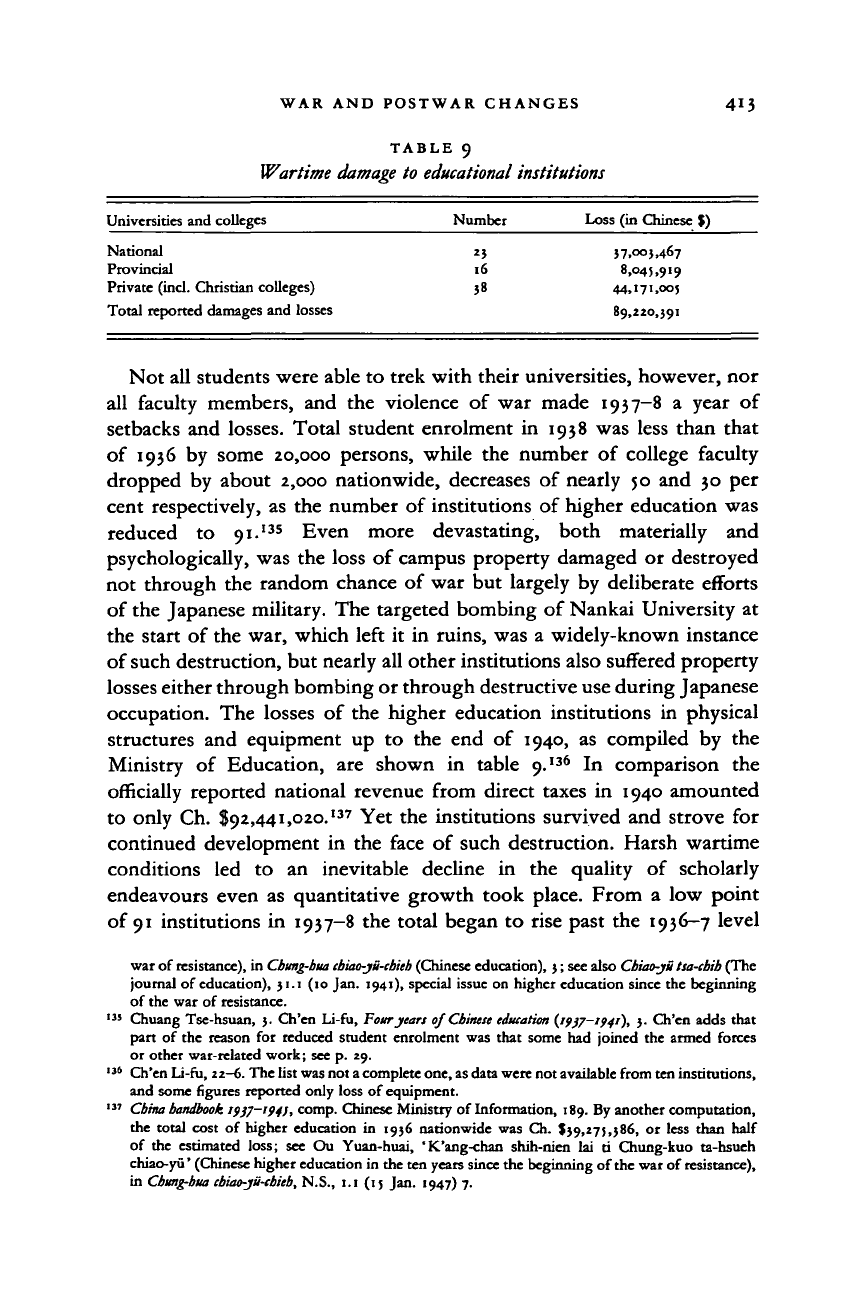
WAR AND POSTWAR CHANGES
TABLE 9
Wartime
damage
to
educational
institutions
Universities
and
colleges Number
Loss
(in
Chinese
$)
National
Provincial
Private (incl. Christian colleges)
Total reported damages
and
losses
16
58
57,005,467
8,O45.9'9
44,171,005
89,220,591
Not
all
students were able
to
trek with their universities, however,
nor
all faculty members,
and the
violence
of
war
made 1937-8
a
year
of
setbacks
and
losses. Total student enrolment
in 1958 was
less than that
of
1936 by
some 20,000 persons, while
the
number
of
college faculty
dropped
by
about 2,000 nationwide, decreases
of
nearly
50 and 30 per
cent respectively,
as the
number
of
institutions
of
higher education
was
reduced
to
9i.
I3s
Even more devastating, both materially
and
psychologically,
was the
loss
of
campus property damaged
or
destroyed
not through
the
random chance
of war but
largely
by
deliberate efforts
of
the
Japanese military.
The
targeted bombing
of
Nankai University
at
the start
of the war,
which left
it
in
ruins,
was a
widely-known instance
of such destruction,
but
nearly
all
other institutions also suffered property
losses either through bombing
or
through destructive use during Japanese
occupation.
The
losses
of
the
higher education institutions
in
physical
structures
and
equipment
up to
the end
of
1940,
as
compiled
by
the
Ministry
of
Education,
are
shown
in
table
9.
136
In
comparison
the
officially reported national revenue from direct taxes
in
1940
amounted
to only
Ch.
$92,44i,o2o.
137
Yet the
institutions survived
and
strove
for
continued development
in
the
face
of
such destruction. Harsh wartime
conditions
led to an
inevitable decline
in the
quality
of
scholarly
endeavours even
as
quantitative growth took place. From
a
low
point
of
91
institutions
in
1937-8
the
total began
to
rise past
the
1936-7 level
war of resistance), in
Cbung-bua cbiao-ju-cbicb
(Chinese education), 5; see also Cbiao-ju
tsa-cbib
(The
journal
of
education), 51.1 (10 Jan. 1941), special issue on higher education since the beginning
of the war
of
resistance.
135
Chuang Tse-hsuan,
5.
Ch'en Li-fu,
Four years
of
Chinese education (19)7-1941),
5.
Ch'en adds that
part
of the
reason
for
reduced student enrolment
was
that some
had
joined
the
armed forces
or other war-related work;
see p. 29.
136
Ch'en Li-fu, 22-6. The list was not
a
complete one, as data were not available from ten institutions,
and some figures reported only loss of equipment.
137
China handbook
19)7-1941, comp. Chinese Ministry of Information, 189. By another computation,
the total cost
of
higher education
in
1956 nationwide was Ch. $59,275,586,
or
less than half
of the estimated loss;
see Ou
Yuan-huai, 'K'ang-chan shih-nien
lai ti
Chung-kuo ta-hsueh
chiao-yu' (Chinese higher education in the ten years since the beginning of the war of resistance),
in
Chung-bun
ebiao-ju-ebieb,
N.S.,
1.1
(15 Jan. 1947)
7.
Cambridge Histories Online © Cambridge University Press, 2008
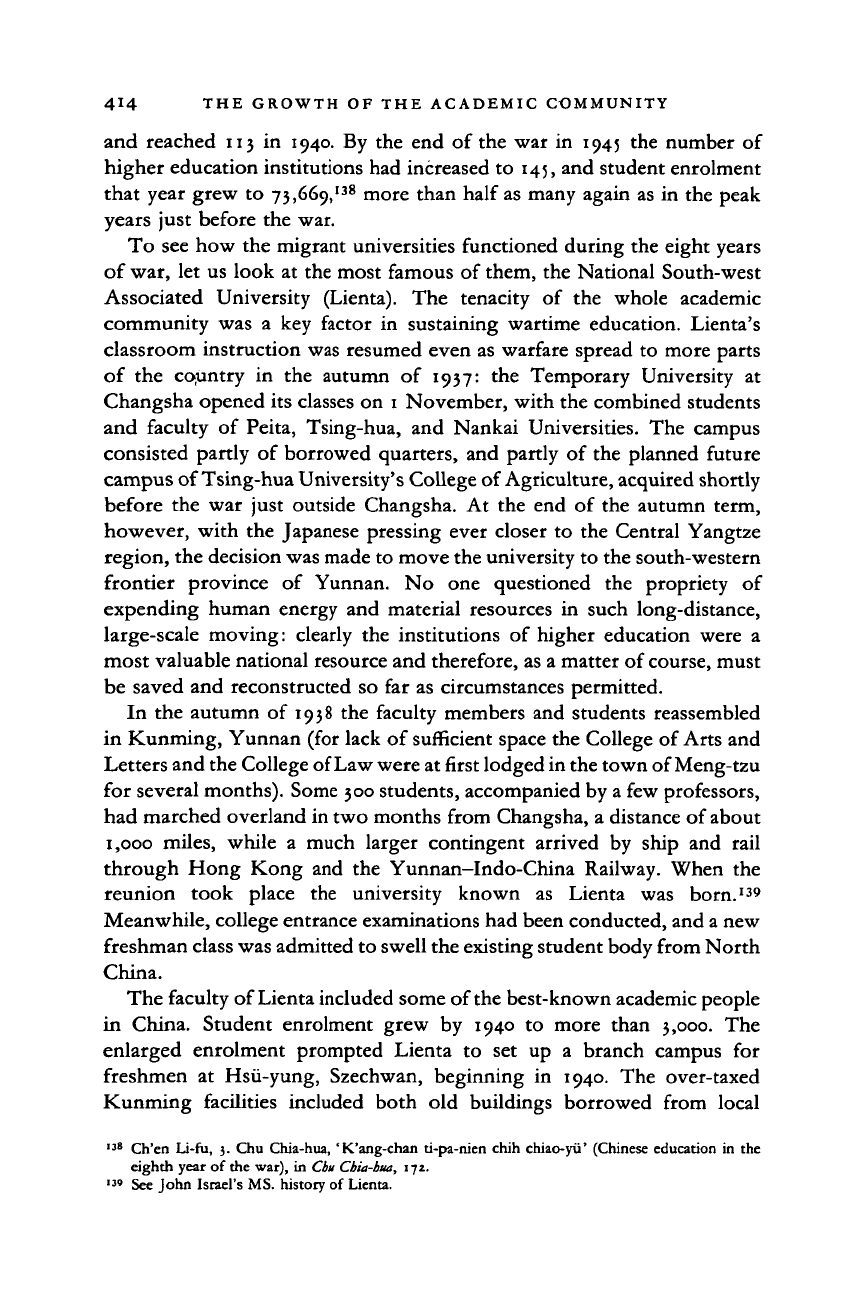
414 THE GROWTH OF THE ACADEMIC COMMUNITY
and reached 113
in
1940. By the end
of
the war
in
1945 the number of
higher education institutions had increased to 145, and student enrolment
that year grew
to
73,669,
138
more than half as many again as in the peak
years just before the war.
To see how the migrant universities functioned during the eight years
of war, let us look at the most famous of them, the National South-west
Associated University (Lienta).
The
tenacity
of the
whole academic
community was
a
key factor
in
sustaining wartime education. Lienta's
classroom instruction was resumed even as warfare spread to more parts
of the country
in the
autumn
of
1937:
the
Temporary University
at
Changsha opened its classes on
1
November, with the combined students
and faculty
of
Peita, Tsing-hua, and Nankai Universities. The campus
consisted partly
of
borrowed quarters, and partly
of
the planned future
campus of Tsing-hua University's College of Agriculture, acquired shortly
before the war just outside Changsha.
At
the end
of
the autumn term,
however, with the Japanese pressing ever closer to the Central Yangtze
region, the decision was made to move the university to the south-western
frontier province
of
Yunnan.
No one
questioned
the
propriety
of
expending human energy and material resources
in
such long-distance,
large-scale moving: clearly the institutions
of
higher education were
a
most valuable national resource and therefore, as a matter of
course,
must
be saved and reconstructed so far as circumstances permitted.
In the autumn
of
1938 the faculty members and students reassembled
in Kunming, Yunnan (for lack of sufficient space the College of Arts and
Letters and the College of Law were at first lodged in the town of Meng-tzu
for several months). Some 300 students, accompanied by a few professors,
had marched overland in two months from Changsha, a distance of about
1,000 miles, while
a
much larger contingent arrived
by
ship and rail
through Hong Kong and the Yunnan-Indo-China Railway. When
the
reunion took place
the
university known
as
Lienta
was
born.
139
Meanwhile, college entrance examinations had been conducted, and a new
freshman class was admitted to swell the existing student body from North
China.
The faculty of Lienta included some of the best-known academic people
in China. Student enrolment grew
by
1940
to
more than 3,000.
The
enlarged enrolment prompted Lienta
to set up a
branch campus
for
freshmen
at
Hsii-yung, Szechwan, beginning
in
1940. The over-taxed
Kunming facilities included both
old
buildings borrowed from local
138
Ch'en Li-fu,
3.
Chu Chia-hua, 'K'ang-chan ti-pa-nien chih chiao-yii' (Chinese education
in the
eighth year
of
the war),
in
Cbu Cbia-bua,
172.
139
See John Israel's MS. history of Lienta.
Cambridge Histories Online © Cambridge University Press, 2008
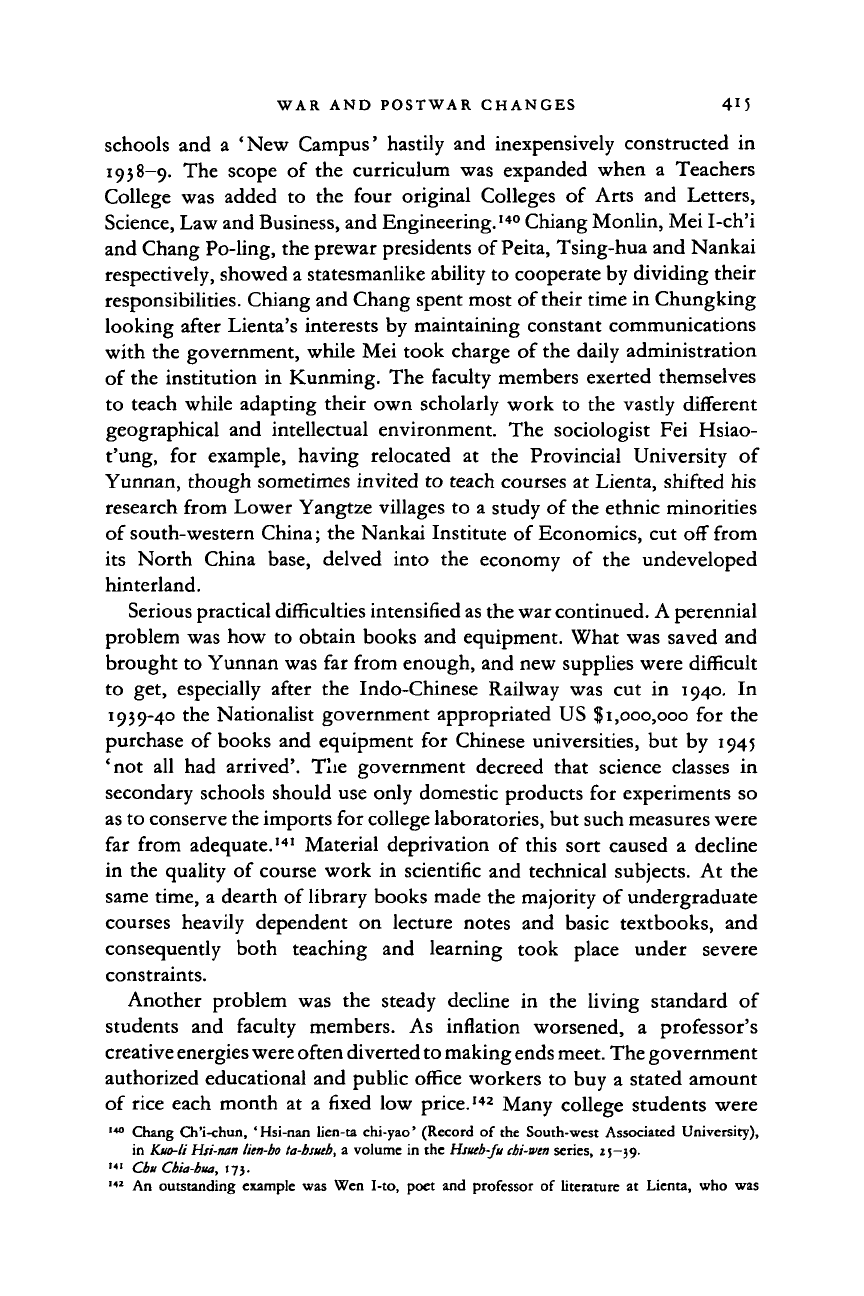
WAR AND POSTWAR CHANGES 4
J
5
schools and a 'New Campus' hastily and inexpensively constructed in
1938—9.
The scope of the curriculum was expanded when a Teachers
College was added to the four original Colleges of Arts and Letters,
Science, Law and Business, and Engineering.
140
Chiang Monlin, Mei I-ch'i
and Chang Po-ling, the prewar presidents of
Peita,
Tsing-hua and Nankai
respectively, showed a statesmanlike ability to cooperate by dividing their
responsibilities. Chiang and Chang spent most of their time in Chungking
looking after Lienta's interests by maintaining constant communications
with the government, while Mei took charge of the daily administration
of the institution in Kunming. The faculty members exerted themselves
to teach while adapting their own scholarly work to the vastly different
geographical and intellectual environment. The sociologist Fei Hsiao-
t'ung, for example, having relocated at the Provincial University of
Yunnan, though sometimes invited to teach courses at Lienta, shifted his
research from Lower Yangtze villages to a study of the ethnic minorities
of south-western China; the Nankai Institute of Economics, cut off from
its North China base, delved into the economy of the undeveloped
hinterland.
Serious practical difficulties intensified
as
the war continued. A perennial
problem was how to obtain books and equipment. What was saved and
brought to Yunnan was far from enough, and new supplies were difficult
to get, especially after the Indo-Chinese Railway was cut in 1940. In
1939-40 the Nationalist government appropriated US $1,000,000 for the
purchase of books and equipment for Chinese universities, but by 1945
'not all had arrived'. The government decreed that science classes in
secondary schools should use only domestic products for experiments so
as to conserve the imports for college laboratories, but such measures were
far from adequate.
141
Material deprivation of this sort caused a decline
in the quality of course work in scientific and technical subjects. At the
same time, a dearth of library books made the majority of undergraduate
courses heavily dependent on lecture notes and basic textbooks, and
consequently both teaching and learning took place under severe
constraints.
Another problem was the steady decline in the living standard of
students and faculty members. As inflation worsened, a professor's
creative energies were often diverted to making
ends
meet.
The government
authorized educational and public office workers to buy a stated amount
of rice each month at a fixed low price.
142
Many college students were
140
Chang Ch'i-chun, 'Hsi-nan lien-ta chi-yao' (Record of the South-west Associated University),
in Kuo-li Hsi-nan lien-bo ta-biuth,
a
volume
in
the Hiueb-fu cbi-wen series, 25—39.
141
Cbu
Cbia-bua, 173.
142
An outstanding example was Wen I-to, poet and professor of literature at Lienta, who was
Cambridge Histories Online © Cambridge University Press, 2008

THE GROWTH OF THE ACADEMIC COMMUNITY
in worse plight. Early in the war the government began granting loans
to the truly impecunious students who had been cut off from their homes,
and
by
1941 more than 16,000 students had received such aid.
143
The
stipends kept the recipients on
a
bare subsistence level, without a healthy
diet
or
enough clothing through
the
year,
let
alone books
and
other
necessities. By early 1941 the saying at Lienta was that you pawned your
winter clothes
to
buy spring term books, then pawned your books
in
the autumn
to
redeem the winter clothes.
A third problem, less immediately visible, posed the most fundamental
difficulty
of
all,
the
relationship between organized authority
and the
liberal intellectual, who perceived himself as one
of
the builders
of a
modern China. The fact that the nation-building endeavour now had
to
be carried out with scarce resources in wartime intensified the differences
in aim between the liberal intellectuals and the KMT party dictatorship.
As minister
of
education, Ch'en Li-fu aspired
to
expand Free China's
student body
and
organize
its
ideological adherence
to
Sun Yat-sen's
Three Principles
of
the People, hoping thereby
to
prevent disaffected
youths turning toward the CCP. The resultant KMT policing of students'
and faculty members' thought led
to a
sharp struggle
at
Lienta. Since
Kunming's inflated prices were higher than
elsewhere,
Lienta's government
rations were even less adequate. Lienta professors opposing
KMT
authoritarianism found support from the local warlord, Governor Lung
Yun
of
Yunnan, who checked the efforts
of
central government agents
to police the university community's political thinking.
In
this situation
differences over seemingly pragmatic issues could lead to polarization of
views.
For example, dissatisfaction with the government's heavy emphasis
on the utilitarian parts of the university curriculum at the expense of the
liberal arts was voiced in 1940 by Ch'ien Tuan-sheng, professor of political
science: ' The basic goal of the university
is
the quest
for
knowledge,
it
is not utility.
If
university education is able, at the same time, to produce
something useful, that is an ancillary function and not its original goal.'
144
This statement was symptomatic
of
the dualism inherent
in the
New
Culture movement: which was more important, to develop the individual
mind through the pursuit
of
knowledge,
or to
apply useful knowledge
for
a
collective national purpose?
compelled
to
teach additional classes
in
the local middle school as well as to carve and sell seals
in order
to
barely support his family. See Liang Shih-ch'iu, T'an Wen I-to 109, quoting from
' Mourning my friend Wen I-to' by Wu Han,
a
professor
of
history
at
Lienta. For
a
perceptive
account that has captured the living conditions and physical exhaustion
of
the majority
of
the
academic community
in
wartime China, see Fairbank,
Cbinabound.
143
Ch'en Li-fu, 30.
144
Ch'ien was professor of political science at Lienta; quoted from John Israel's manuscript. Ch'ien's
subsequent study,
Tbc government
and
politics
of
China,
analyses the growth
of
KMT militarism.
Cambridge Histories Online © Cambridge University Press, 2008
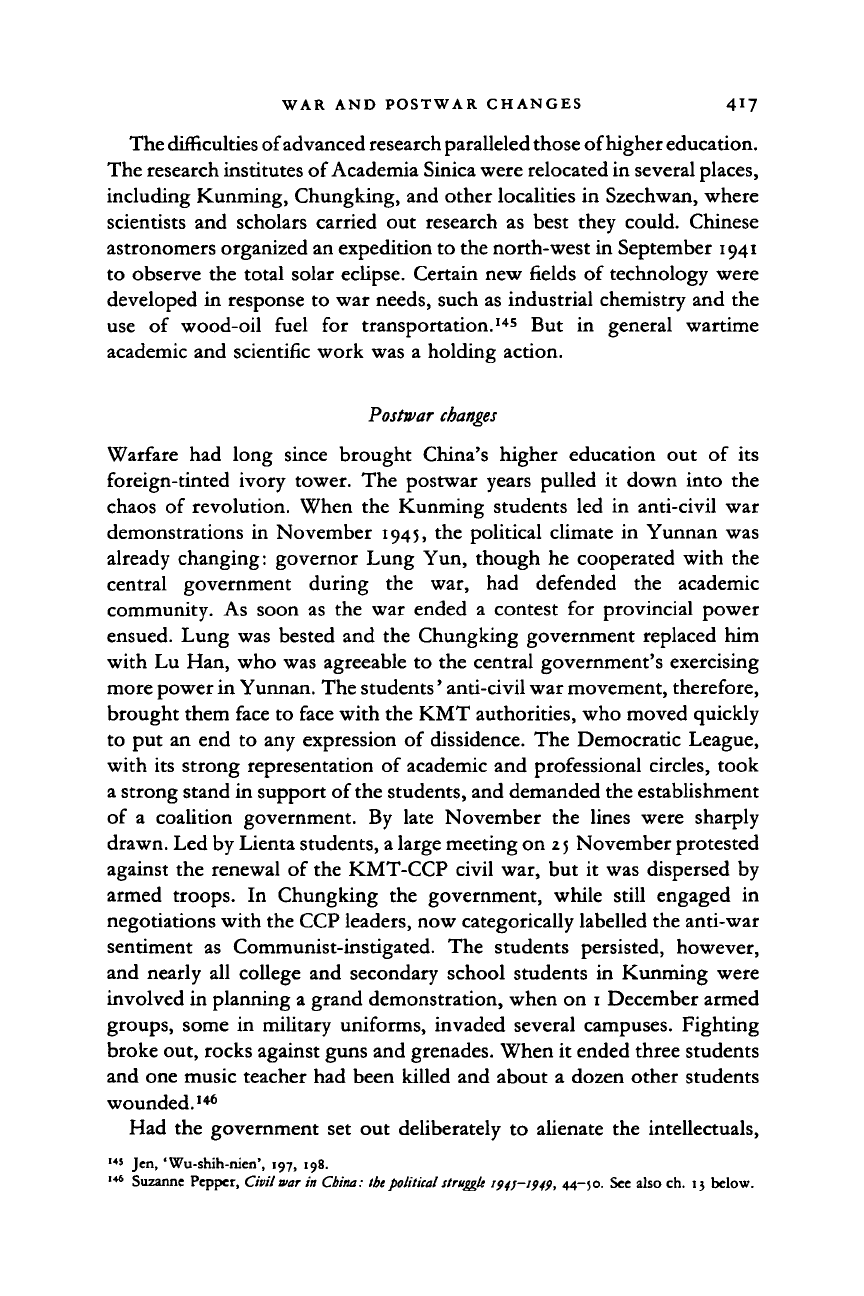
WAR AND POSTWAR CHANGES 417
The difficulties of advanced research paralleled those of higher education.
The research institutes of Academia Sinica were relocated in several places,
including Kunming, Chungking,
and
other localities
in
Szechwan, where
scientists
and
scholars carried
out
research
as
best they could. Chinese
astronomers organized an expedition to the north-west in September 1941
to observe
the
total solar eclipse. Certain
new
fields
of
technology were
developed
in
response
to war
needs, such
as
industrial chemistry
and the
use
of
wood-oil fuel
for
transportation.
145
But in
general wartime
academic
and
scientific work was
a
holding action.
Postwar changes
Warfare
had
long since brought China's higher education
out of its
foreign-tinted ivory tower.
The
postwar years pulled
it
down into
the
chaos
of
revolution. When
the
Kunming students
led in
anti-civil
war
demonstrations
in
November 1945,
the
political climate
in
Yunnan
was
already changing: governor Lung Yun, though
he
cooperated with
the
central government during
the war, had
defended
the
academic
community.
As
soon
as the war
ended
a
contest
for
provincial power
ensued. Lung
was
bested
and the
Chungking government replaced
him
with
Lu
Han, who was agreeable
to the
central government's exercising
more power in Yunnan. The students' anti-civil war movement, therefore,
brought them face
to
face with the KMT authorities, who moved quickly
to
put an end to any
expression
of
dissidence.
The
Democratic League,
with
its
strong representation
of
academic
and
professional circles, took
a strong stand
in
support of the students, and demanded the establishment
of
a
coalition government.
By
late November
the
lines were sharply
drawn. Led by Lienta students, a large meeting on
2 5
November protested
against
the
renewal
of
the KMT-CCP civil
war, but it
was dispersed
by
armed troops.
In
Chungking
the
government, while still engaged
in
negotiations with the CCP leaders, now categorically labelled the anti-war
sentiment
as
Communist-instigated.
The
students persisted, however,
and nearly
all
college
and
secondary school students
in
Kunming were
involved
in
planning a grand demonstration, when
on
1
December armed
groups, some
in
military uniforms, invaded several campuses. Fighting
broke out, rocks against guns and grenades. When
it
ended three students
and one music teacher
had
been killed
and
about
a
dozen other students
wounded.
146
Had
the
government
set out
deliberately
to
alienate
the
intellectuals,
145
Jen,' Wu-shih-nien",
197, 198.
146
Suzanne Pepper, Chit war in China: tbt political
struggle
194J-1949, 44-50.
See
also
ch. 13
below.
Cambridge Histories Online © Cambridge University Press, 2008
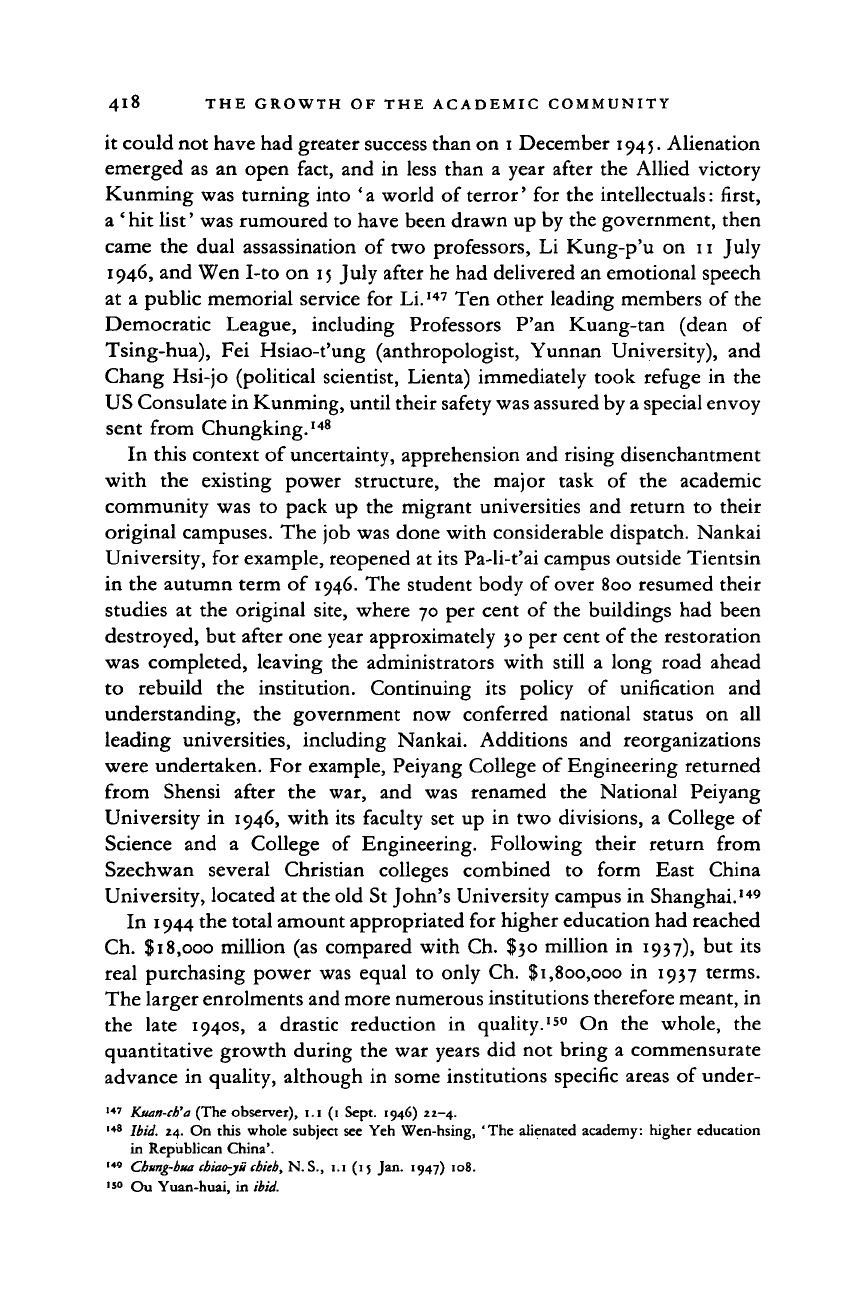
418 THE GROWTH OF THE ACADEMIC COMMUNITY
it could not have had greater success than on
i
December 1945. Alienation
emerged as
an
open fact, and in less than
a
year after the Allied victory
Kunming was turning into '
a
world of terror' for the intellectuals: first,
a 'hit list' was rumoured to have been drawn up by the government, then
came the dual assassination
of
two professors,
Li
Kung-p'u
on
11 July
1946,
and Wen I-to on 15 July after he had delivered an emotional speech
at
a
public memorial service for Li.
147
Ten other leading members of the
Democratic League, including Professors
P'an
Kuang-tan (dean
of
Tsing-hua),
Fei
Hsiao-t'ung (anthropologist, Yunnan University),
and
Chang Hsi-jo (political scientist, Lienta) immediately took refuge
in
the
US Consulate in Kunming, until their safety was assured by a special envoy
sent from Chungking.
148
In this context of uncertainty, apprehension and rising disenchantment
with
the
existing power structure,
the
major task
of the
academic
community was
to
pack up the migrant universities and return
to
their
original campuses. The job was done with considerable dispatch. Nankai
University, for example, reopened at its Pa-li-t'ai campus outside Tientsin
in the autumn term
of
1946. The student body of over 800 resumed their
studies
at
the original site, where 70 per cent
of
the buildings had been
destroyed, but after one year approximately 30 per cent of the restoration
was completed, leaving the administrators with still
a
long road ahead
to rebuild
the
institution. Continuing
its
policy
of
unification
and
understanding,
the
government
now
conferred national status
on all
leading universities, including Nankai. Additions
and
reorganizations
were undertaken. For example, Peiyang College of Engineering returned
from Shensi after
the war, and was
renamed
the
National Peiyang
University in 1946, with its faculty set up
in
two divisions,
a
College of
Science
and a
College
of
Engineering. Following their return from
Szechwan several Christian colleges combined
to
form East China
University, located at the old St John's University campus in Shanghai.
149
In 1944 the total amount appropriated for higher education had reached
Ch. $18,000 million (as compared with Ch. $30 million
in
1937), but its
real purchasing power was equal
to
only Ch. $1,800,000
in
1937 terms.
The larger enrolments and more numerous institutions therefore meant, in
the late 1940s,
a
drastic reduction
in
quality.
150
On the
whole,
the
quantitative growth during the war years did not bring
a
commensurate
advance in quality, although in some institutions specific areas of under-
147
Kuan-cb'a
(The observer), I.I
(i
Sept. 1946) 22-4.
1+8
Ibid.
24. On this whole subject see Yeh Wen-hsing, 'The alienated academy: higher education
in Republican China'.
149
Cbung-bua cbiao-ju cbieb, N. S.,
1.1
(15 Jan. 1947) 108.
150
Ou Yuan-huai, in
ibid.
Cambridge Histories Online © Cambridge University Press, 2008
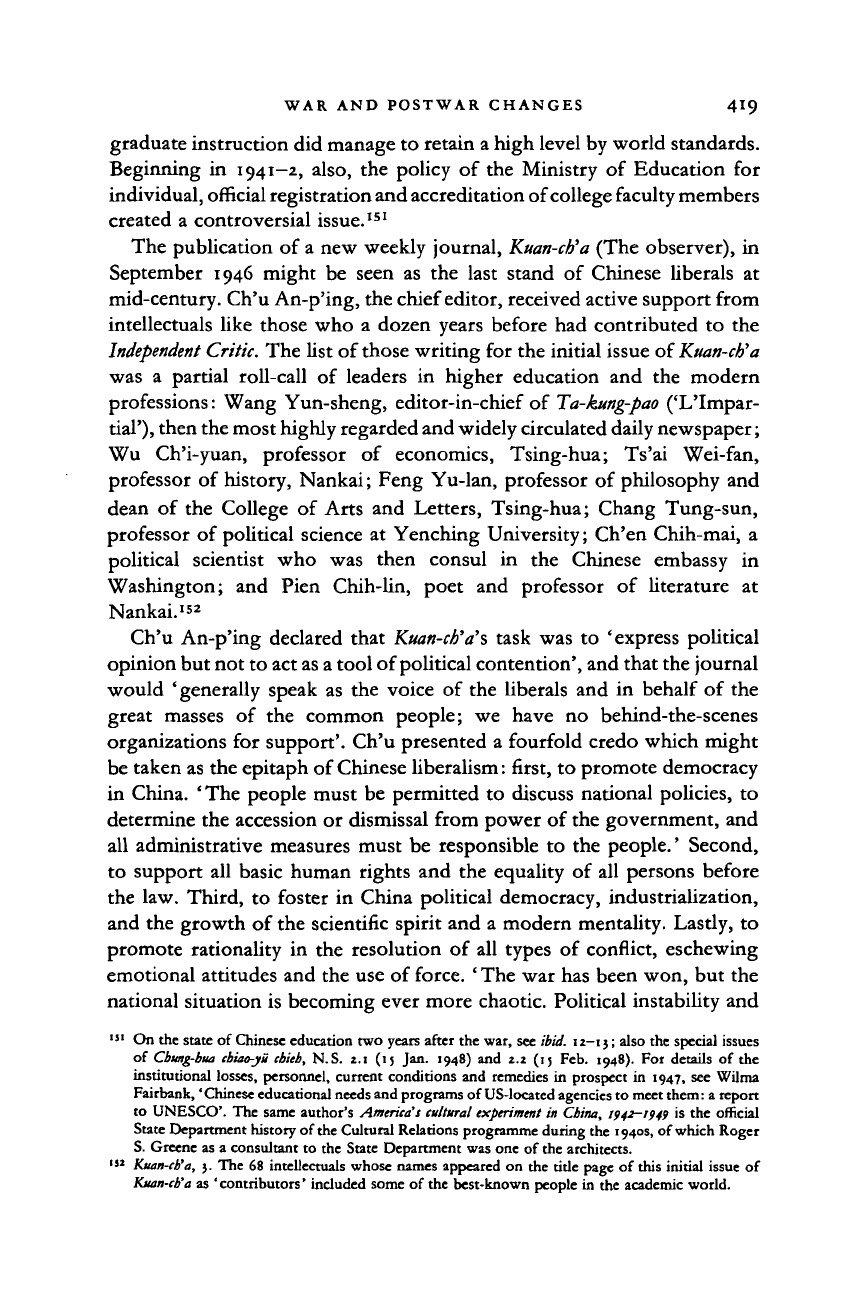
WAR AND POSTWAR CHANGES 419
graduate instruction did manage to retain a high level by world standards.
Beginning in 1941-2, also, the policy of the Ministry of Education for
individual, official registration and accreditation of college faculty members
created a controversial issue.
151
The publication of a new weekly journal,
Kuan-ch'a
(The observer), in
September 1946 might be seen as the last stand of Chinese liberals at
mid-century. Ch'u An-p'ing, the chief editor, received active support from
intellectuals like those who a dozen years before had contributed to the
Independent
Critic.
The list of those writing for the initial issue of
Kuan-ch'a
was a partial roll-call of leaders in higher education and the modern
professions: Wang Yun-sheng, editor-in-chief of
Ta-kung-pao
('L'lmpar-
tial'), then the most highly regarded and widely circulated daily newspaper;
Wu Ch'i-yuan, professor of economics, Tsing-hua; Ts'ai Wei-fan,
professor of history, Nankai; Feng Yu-lan, professor of philosophy and
dean of the College of Arts and Letters, Tsing-hua; Chang Tung-sun,
professor of political science at Yenching University; Ch'en Chih-mai, a
political scientist who was then consul in the Chinese embassy in
Washington; and Pien Chih-lin, poet and professor of literature at
Nankai. «
2
Ch'u An-p'ing declared that
Kuan-cb'a's
task was to 'express political
opinion but not to act as a tool of political contention', and that the journal
would ' generally speak as the voice of the liberals and in behalf of the
great masses of the common people; we have no behind-the-scenes
organizations for support'. Ch'u presented a fourfold credo which might
be taken as the epitaph of Chinese liberalism: first, to promote democracy
in China. 'The people must be permitted to discuss national policies, to
determine the accession or dismissal from power of the government, and
all administrative measures must be responsible to the people.' Second,
to support all basic human rights and the equality of all persons before
the law. Third, to foster in China political democracy, industrialization,
and the growth of the scientific spirit and a modern mentality. Lastly, to
promote rationality in the resolution of all types of conflict, eschewing
emotional attitudes and the use of force. ' The war has been won, but the
national situation is becoming ever more chaotic. Political instability and
ISI
On the state of Chinese education two years after the war, see
ibid.
12-13; ^
so tne
special issues
of Cbung-bua cbiao-yu cbieb, N. S. 2.1 (15 Jan. 1948) and 2.2 (15 Feb. 1948). For details of the
institutional losses, personnel, current conditions and remedies in prospect in 1947, see Wilma
Fairbank,' Chinese educational needs and programs of US-located agencies to meet them: a report
to UNESCO'. The same author's
America's cultural experiment
in
Cbina,
1942-190 is the official
State Department history of
the
Cultural Relations programme during the 1940s, of which Roger
S. Greene as a consultant to the State Department was one of the architects.
1)1
Kuan-cb'a,
3. The 68 intellectuals whose names appeared on the title page of this initial issue of
Kuan-cb'a
as
'
contributors'
included some of the best-known people in the academic world.
Cambridge Histories Online © Cambridge University Press, 2008
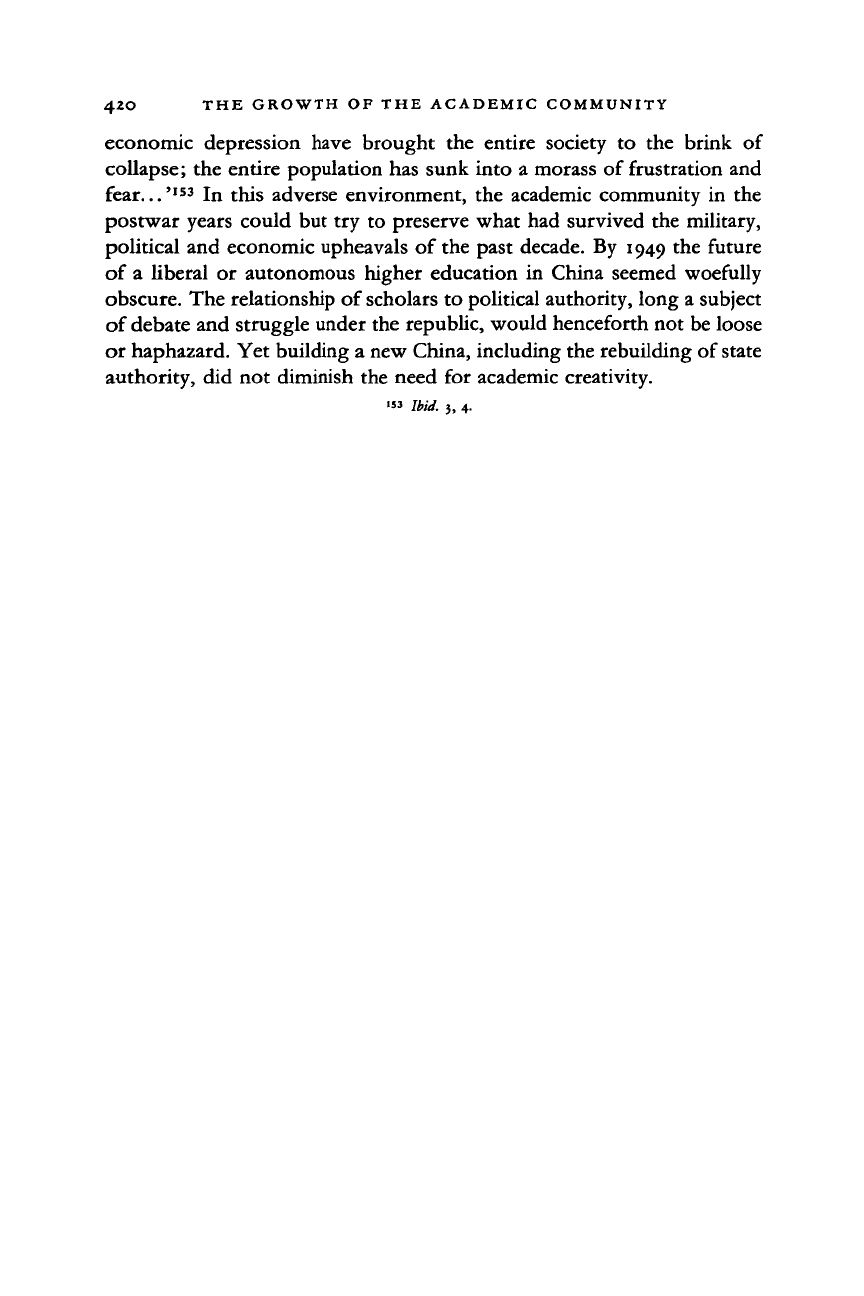
42O THE GROWTH OF THE ACADEMIC COMMUNITY
economic depression have brought the entire society to the brink of
collapse; the entire population has sunk into a morass of frustration and
fear...
>IS3
In this adverse environment, the academic community in the
postwar years could but try to preserve what had survived the military,
political and economic upheavals of the past decade. By 1949 the future
of a liberal or autonomous higher education in China seemed woefully
obscure. The relationship of scholars to political authority, long a subject
of debate and struggle under the republic, would henceforth not be loose
or haphazard. Yet building a new China, including the rebuilding of state
authority, did not diminish the need for academic creativity.
'"
Ibid,
i, 4.
Cambridge Histories Online © Cambridge University Press, 2008
